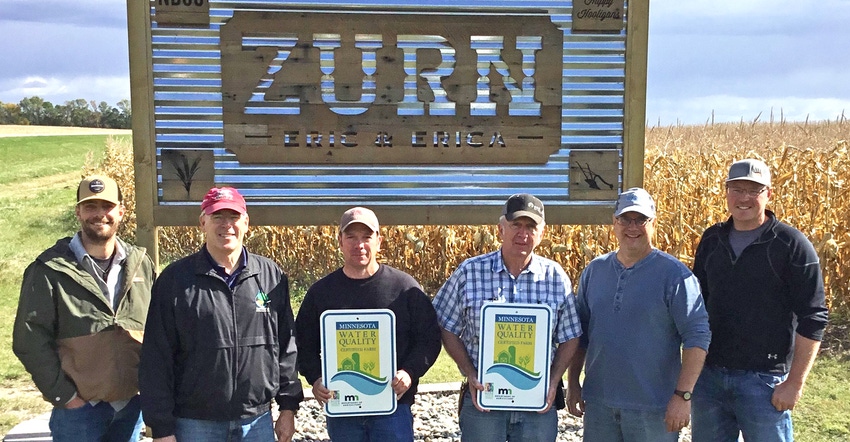
As one of the original committee members involved with the Minnesota Ag Water Quality Certification Program, Bill Zurn of Calloway, Minn., knows well the challenges and the importance of establishing a new program to be thorough, fair and effective.
MAWQCP, which rolled out as a pilot in 2012, is a voluntary program for farmers and landowners who implement specific conservation and farm management practices that will help protect water quality. Once approved for the program, farmers receive regulatory certainty for 10 years, meaning that they are considered in compliance with any new water quality rules or laws that would be passed during the period of certification.
The Zurn farm, involving Bill, wife Karolyn and sons Eric and Nick, recently became MAWQ-certified. Their operation joins more than 1,000 Minnesota growers representing more than 733,000 acres certified in the program. The Zurns raise corn, soybeans, and sometimes spring wheat and alfalfa on their crop farm.
Certification took time
“It took a while for us to get certified,” Bill says. “We had to change some crop rotations and fall tillage [to qualify].” Even with their numerous conservation practices in place, they needed to complete a few more.
They worked closely with Jim Lahn, MAWQCP area certification specialist, based in the East Otter Tail Soil and Water Conservation District office, to meet program standards. Bill credits both Lahn and Natural Resources Conservation Service staff with helping them get certified.
“We farm in both Becker and Mahnomen counties, and they worked hard to help us,” he adds.
Each farm has a unique soil type, topography and type of operation, so a variety of practices must be fit to the land. To earn certification, the Zurns’ overall water quality protection plan looks like this:
Conservation tillage. The Zurns are reducing tillage on their heavy soils to leave more crop residue cover to prevent erosion caused by rain or wind. They find cornstalk residue provides up to 50% to 60% cover on the soil. And after they changed to less aggressive tillage after soybean harvest, they saw soil covered by 30% to 50% soybean crop residue. Eric says using narrower straight shanks on the chisel plow helps level more surface residue.
Cover crops. In recent crop seasons, the Zurns have planted fall cover crops — either winter rye or wheat — after harvest. In the spring, light tillage or an application of herbicide terminates it.
Nutrient management. The Zurns broadcast and lightly till in fertilizer to incorporate it in the spring prior to planting. They regularly take soil samples for testing, and they base fertilizer decisions based on university recommendations for phosphate, potash and other nutrients. They also work with a crop consultant who develops a detailed fertilizer application plan for each growing season.
Pest management. Their crop consultant also scouts fields for pests and provides reports. The Zurns use these reports to help them make treatment decisions based on university thresholds of pests, such as soybean aphids. They rotate modes of action among crop protection products to help prevent pest resistance issues. They’ve also sampled for soybean cyst nematodes and used drones to gather field information.
Gully erosion control and filter strips. Over the years, the Zurns have installed more than 80 water and sediment control basins in areas of concentrated flow of water. They plan to add more in the future, too. They have worked with NRCS and SWCD for cost-share on these projects, as well as investing their own money into building them. They also have established numerous grassed filter strips along the small lakes, ponds and creeks on their farmland.
“The Zurns use a system of conservation practices that protect our water and soil — conservation tillage, erosion control dams, grassed filter strips, and excellent nutrient and pest management,” Lahn notes. “It was very good working with the Zurn family, and I congratulate them on achieving water quality certification for their farming operations.”
About the Author(s)
You May Also Like






